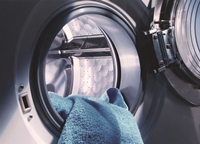Laundry detergents are sometimes
compared on performance, e.g. by consumer organisations. But to be
useful for consumers, it is important that these tests are of high
quality and offer a realistic and reliable comparison of product
characteristics.
A.I.S.E. developed
its first detergent testing guidelines in 2009 and has since been
updating it on a regular base, making it available to manufacturers and
other interested parties such as consumer organisations and testing
institutes. |
 |
The protocol provides a minimum requirement methodology for
assessing the performance of laundry detergents (heavy duty and light
duty) and laundry additives across Europe. The Guidelines have been
developed based on experts' knowledge from major companies manufacturing
such products, after a thorough review of existing test protocols used
in Europe and of existing internal company data.
Downloads
The protocol comprises (as minimum requirements - bearing in mind that organisations may feel free to exceed them):
A.I.S.E. reviews this protocol regularly. Please address your feedback, reactions, suggestions and questions directly to
[email protected].
Status of the review of the protocol – April 2023
Stain Set - several changes to the stain set to improve consumer relevance and discriminative power. The stain set still comprises 14 stains and contains now 3 new stains (added in May 2020) and 3 alternative supplier choices (2 added in May 2020 and 1 added in October 2020) as well as one technical change.
Dye Transfer Inhibition Protocol - this project has been temporarily suspended for priority reasons.
Whiteness Maintenance Protocol - the group has started a program to further improve the whiteness test method in a more consumer relevant way. End March 2023 the group reviewed the progress and agreed to modify the approach - next review is planned before the end of 2023.
History of protocol update
| Version |
Date |
Comments |
| V.1. |
February 2009 |
Original stain set |
| V.2. |
July 2012 |
Changes to the stain set:
Interim situation for the red wine stain, as offered by Equest (one of the stain providers) |
| V.3. |
June 2013 |
Changes to the stain set:
New stains for red wine and frying fat (hamburger grease) |
| V.4. |
July 2013 |
Changes to the stain set:
Replacement of stain WFK 10M for unused motor oil by WFK 10RM |
| V.5. |
November 2013 |
Changes to the stain set:
New stains for coffee and tea |
| V.5.1.
|
April 2016
|
No changes to the test requirements, only editorial changes.
The files have been updated to reflect change in the name of the
project (previously "Detergent Test Protocol") and to include: initial
disclaimer on the use of the protocol; translation from English of
missing text on slide related to the evaluation of degree of stain
removal; inclusion of list of acronyms at the end. |
| V.5.2 |
June 2018 |
Clarification
on the purpose of the guidelines (for comparative performance testing
of detergents, NOT washing conditions) and on the choice of washing
cycle(s). |
| V.6. |
May 2020
|
Changes
to the stain set:
Replacement of Baby Food by Salad Dressing Balsamico C-S-406;
Replacement of Burnt Beef by Cooked Beef Fat on polyester/cotton WE5BBPC2;
Replacement of Grass by Pure Grass C-S-07 and addition of Scrubbed Grass
WE5SGWKC as alternative choice;
Addition of Face Make-up WE5FM2WKC as alternative choice.
|
V.7.
|
October 2020
|
Changes to the stain set:
Addition of Tea C-S-97 as alternative choice.
Replacement of Unused Motor Oil C-01 by C-01s (this is a technical change). |
| V.8. |
April 2023 |
SBL-CFT is now also accepted as alternative to wfk-SBL2004 |
If you wish more information about the stain update, please check this
document.